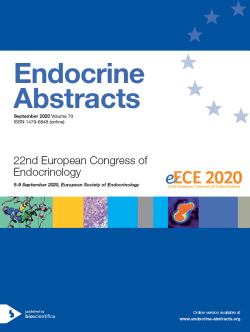
22nd European Congress of Endocrinology
Online
05 Sep 2020 - 09 Sep 2020
Oral Communications
Diabetes, Obesity, Metabolism and Nutrition
ea0070oc3.1 | Diabetes, Obesity, Metabolism and Nutrition | ECE2020
Twenty-two years results of the israeli-georgian program diabetes in pregnancy
Asatiani Natalia , Kurashvili Ramaz , Inashvili Ekaterine , Shelestova Elena , Dundua Mzia
ea0070oc3.2 | Diabetes, Obesity, Metabolism and Nutrition | ECE2020
Influence of obesity in the miRNome landscape: miR-4454, a tissue-specific regulator of insulin response
Sáez-Martínez Prudencio , Herrero-Aguayo Vicente , Jiménez-Vacas Juan M , López-Cánovas Juan L , Garrido-Sánchez Lourdes , Macías-González Manuel , López-Miranda José , Gómez--Gómez Enrique , Castaño-Fuentes Justo P , Gahete-Ortíz Manuel D , Luque-Huertas Raúl M
ea0070oc3.3 | Diabetes, Obesity, Metabolism and Nutrition | ECE2020
Circulating follistatin predicts type 2 diabetes risk
Wu Chuanyan , Borné Yan , Gao Rui , López Rodriguez Maykel , Roell William , Wilson Jonathan , Ahlqvist Emma , Luan Cheng , Peter Andreas , Machann Jürgen , Hong Mun-Gwan , Schwenk Jochen , Nilsson Peter , Shore Angela , Khan Faisel , Natali Andrea , Melander Olle , Orho-Melander Marju , Nilsson Jan , Renström Erik , Wollheim Claes , Pearson Ewan , Franks Paul , White Morris , Duffin Kevin , Vaag Allan , Laakso Markku , Stefan Norbert , Groop Leif , De Marinis Yang
ea0070oc3.4 | Diabetes, Obesity, Metabolism and Nutrition | ECE2020
Dietary intake of fat and oil are associated with expression of miR-143 and miR-34a in visceral and subcutaneous adipose tissues: A nutriepigenetic study
Mahmoodi Behnaz , Yuzbashian Emad , Asghari Golaleh , Zarkesh Maryam , Hedayati Mehdi , mirmiran Parvin , Khalaj Alireza
ea0070oc3.5 | Diabetes, Obesity, Metabolism and Nutrition | ECE2020
Supplementation with Bifidobacterium breve BR03 and Bifidobacterium breve B632 favoured weight loss and improved insulin metabolism in children and adolescents with obesity in the BIFI-OBESE cross-over, randomized placebo-controlled trial
Solito Arianna , Hasballa Iderina , Calgaro Matteo , Bozzi Cionci Nicole , Ricotti Roberta , Caputo Marina , Genoni Giulia , Monzani Alice , Archero Francesca , Bellone Simonetta , Bona Gianni , Agosti Emanuela , Aimaretti Gianluca , Amoruso Angela , Pane Marco , Vitulo Nicola , Di Gioia Diana , Prodam Flavia
ea0070oc3.6 | Diabetes, Obesity, Metabolism and Nutrition | ECE2020
11β-Hydroxysteroid dehydrogenase type 1 inhibition protects against the development of adverse metabolic and bone effects of prednisolone: A randomized, double-blind, placebo-controlled trial
Othonos Nantia , Pofi Riccardo , Arvaniti Anastasia , Whittaker Andrew , Stewart Paul , Coleman Ruth , Agbaje Olorunsola , Milton Joanne , Holman Rury , Tomlinson Jeremy W
ea0070oc3.7 | Diabetes, Obesity, Metabolism and Nutrition | ECE2020
Efficacy and safety of volanesorsen for the treatment of metabolic complications in patients with familial partial lipodystrophy: results of the BROADEN study
O’Dea Louis , Tami Joseph , Alexander Veronica , Watts Lynnetta , Hurh Eunju , Hubbard Brant , Schmidt Hartmut , Tiulpakov Anatoly , Mertens Ann , Garg Abhimanyu , Oral Elif



